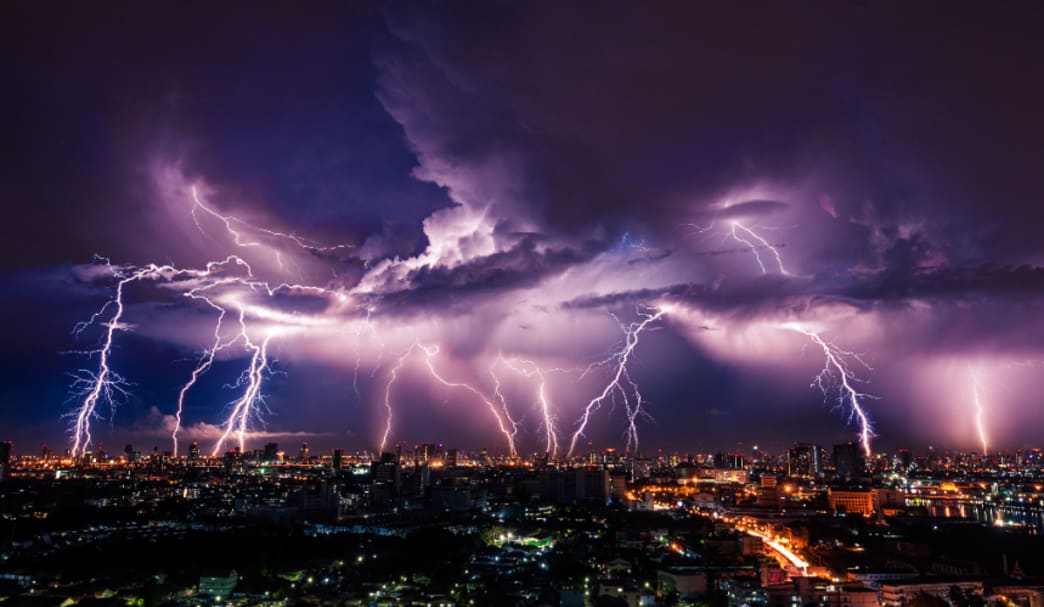US Customer Support
US-based Customer Support
Free US Shipping on Orders Over $100

National Lightning Safety Awareness Week is observed every year in the third week of June—June 19 to June 25 this year. Did you know that an estimated 1,000 people get struck by lightning each year in the US alone? Lightning strikes cause several deaths, and people who survive being struck by lighting often suffer from neurological issues.
Much of the United States has been struck by a heat wave this week, and if you’re like the many of us relying on window AC units for relief, this week may have been when you’ve decided to haul your AC from its winter residence in the basement or attic. Along with this change in temperature, we often experience bouts of more severe weather, including periods of heavy rain, wind, and thunder and lightning storms.
The National Weather Service—which provides weather, water and climate data, forecasts, warnings, and other environmental information that allows us to plan for, prepare for, and respond to natural and human-caused events—started National Lightning Safety Awareness Week in 2001 in order to call attention to the deadliness of lightning. Since then, lightning fatalities in the US have dropped from about 55 per year to less than 30—a decrease of more than 50 percent!
Your odds of being struck by lightning depend on your behavior when thunderstorms are in the area. If you are able to get inside before lightning becomes a threat, your odds of being struck are near zero. How do you know if lightning is a threat? If you can hear thunder, you are close enough to be struck by lightning.
Apart from audible thunder, other signs that lightning is imminent include a rapidly growing cumulonimbus cloud, increasing winds and a darkening sky—telltale signs of an approaching storm— and a severe thunderstorm warning. Therefore, even if you can't hear thunder, you might nonetheless be at risk—which means that keeping an eye on your local forecast during months when thunderstorms are common is important!
Aware of a threat of severe weather? Lightning may be seconds from striking if you perceive any of these: you see your hair standing on end or feel tingling, you taste something metallic, you smell the scent of ozone (the smell you notice after a rainstorm, similar to chlorine), you start to get dizzy or sweat, or you can hear vibrating, buzzing, or crackling.
Don’t forget: a direct strike is not the only way the electricity of lightning can enter your body! Lightning actually strikes in five different ways: direct strike, side flash (when lightning strikes a taller object near the victim and a portion of the current jumps from that object to the victim), ground current, conduction, and streamers. Learn more about these different types of strikes here.
Indoors? Avoid water, because lightning can travel through a building’s plumbing. Don’t touch electronic equipment, as lightning can travel through electrical systems. Avoid windows, doors, porches, and concrete—lightning can travel through any metal wires or bars in concrete walls or flooring. And don’t use corded phones.
If you’re unable to get inside a structure or vehicle during a severe weather threat, immediately get off elevated areas such as hills, mountain ridges, or peaks. Also:
Never lie flat on the ground—crouch down in a ball-like position with your head tucked and hands over your ears so that you are down low with minimal contact with the ground.
Never shelter under an isolated tree—if you are in a forest, shelter near shorter trees.
Never use a cliff or rocky overhang for shelter.
Immediately get out of and away from ponds, lakes, and other bodies of water.
Stay away from objects that conduct electricity, such as barbed wire fences, power lines, or windmills.
Separate from others.
Get more details on the importance of these tips from the CDC here.
If you are with someone you think has been struck, call 911.
You can check for these symptoms of lightning injury: hearing or vision loss; fast or irregular heartbeat or chest pain; headache, trouble staying awake, confusion, or dizziness; shortness of breath; muscle pain, weakness, stiffness, or temporary paralysis; skin burns; or passing out, having a weak pulse, or having no pulse.
Share this hands-on electrostatic demonstration kit from Eisco Labs with your students! The kit demonstrates charging behavior, charge storage, attraction and repulsion, distribution of a charge on surface and induction. The fun experiment proves that lightning is electricity and aids in understanding the importance of protecting things from the effects of lightning.
Check out this series of topics that you can use to lead discussions with students or loved ones throughout the week to learn more about this powerful force of nature. For more lightning safety tips, review this PDF published by the NYS Department of Health.